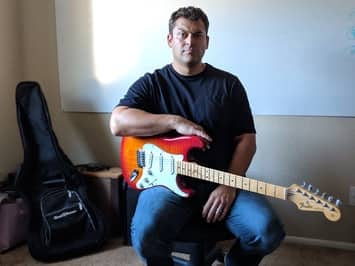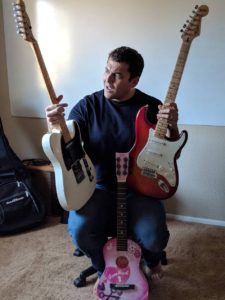
I remember like it was yesterday getting my first guitar for my 9th birthday. It was one of the most exciting moments in my life.
Even as a young kid and a guitar lesson once a week I still remember feeling overwhelmed.
Whether you’re a child or an adult, it can feel like quite a challenging task on how to get started.
If you’re just starting out on guitar, you may have found yourself wondering where to start?
You should always concentrate on the following 3 categories to keep yourself progressing and improving as a player:
- Chords and Rhythm
- Single String (scales)
- Music Theory
I’ve put together a 12 tip road map to help get you off on the right track.. let’s get started, shall we?
If you want to fast track your success I highly recommend checking out my full review of Guitar Tricks here.
Contents
- 1 Tip 1: Understanding the Anatomy of the Guitar
- 2 Tip 2: How to choose a guitar to start learning
- 3 Tip 3: Learn the Name Of The Guitar Strings Right Away
- 4 Tip 4: How To Hold The Guitar Pick Properly
- 5
- 6 Tip 5: Learn to Tune Your Guitar
- 7
- 8 Tip 6: Decide what type of player you aspire to be
- 9 Tip 7: Learn with YouTube
- 10 Tip 8: Learn with an Instructor
- 11 Tip 9: Learn with Online Paid Programs
- 12 Tip 10: Set up a practice schedule
- 13 Tip 11: Use a metronome from the beginning
- 14 Tip 12: Track your progress
- 15 In Conclusion:
Tip 1: Understanding the Anatomy of the Guitar
If someone were to ask you what the tuning knobs do on the guitar would you be able to answer them?
That one was kind of an easy one as it’s purpose is right in the name of it, but it’s crucial for us to understand the different parts of the guitar and their use.
This allows us not only to start to lay the foundation of becoming a guitarist. But, also if you can learn what the parts are supposed to do, you will be able to detect issues if one of the components starts not working and functioning as it should.
The best way to learn the parts of the guitar is to merely look at the diagram below and see if there are any parts that you don’t know what they do.
If you find a piece and don’t know what it does my best recommendation is to go over to YouTube and search for an explanation of that exact part.
A visual representation of this usually clears up any confusion right away.
So, for example, let’s say you’re not quite sure as to what the pickups on an electric guitar actually do.
You would go over to YouTube and search just that.
“What do pickups do on the electric guitar.”
You will find multiple videos learning everything there is to know about pickups.
Don’t get carried away though, having a simple understanding of how guitar anatomy works will do just fine for now. You’ll learn more as you go! Onward and Upward!
Tip 2: How to choose a guitar to start learning
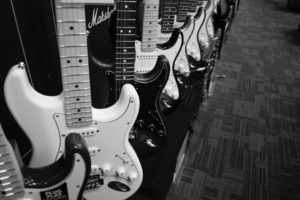
Photo by Stephen Niemeier from Pexels
This tip is apparently for people who don’t own a guitar yet. If you already have a guitar, you can skip to Tip 3.
If you don’t own a guitar again, there are a few guidelines I would take a look at before purchasing a guitar.
- Budget- Even if you can afford a $1,500.00 American Stratocaster, it doesn’t necessarily mean that you should.
- My reasoning for this is that for some reason I see many people just starting out feeling as if they have a higher quality guitar that it will be easier to learn or that you will get better faster.
- Unfortunately, it just doesn’t work that way. I wish it did too, lol! In the beginning, the only benefit I see from having a high-end instrument would be the fact that it will stay in tune longer, which might actually be a disadvantage as that is one of the things that you need to learn how to do is keep your ax in tune! ( oh yeah, we call guitars axes occasionally, it’s part of the dorky guitarist society:)
- Style of music- What style of music do you intend to start learning once you have the fundamentals down?
- If you really love metal music and that’s where you want to focus your learning after the basics, well then purchasing an acoustic guitar may not be your best option in the beginning. So a little bit of forethought should be considered when deciding on electric or acoustic, to begin with.
- Working with what you’ve got- I would recommend a guitar around at least $300.00 check out my beginner guitar recommendations here
- I just simply wouldn’t spend much less than that. Reason being is guitars that are much cheaper than that tend to have some severe tuning issues, and there is nothing more frustrating than continually tuning rather than playing!
Don’t let this tip trip you up.
Often people put too much time into researching a guitar before they ever get going, find something reasonable with good reviews and go with it.
Once you get going seriously with the guitar, you’ll probably end up purchasing more. We all do, it’s a weakness! Learn
Tip 3: Learn the Name Of The Guitar Strings Right Away
The reason that I believe this tip is so valuable is that every lesson from here on out people will refer to the guitar strings by name.
There is nothing more annoying than trying to understand which string they are talking about. Even in a video lesson, if they say for example, “then you pluck the B string.”
If you are clueless which string is the B, it gets easy to become lost and throw in the towel for the day.
Don’t do this. Learning the 6 open strings of the guitar is actually quite simple. I use a simple silly acronym that allows me always to remember.
6th String Low E
5th String A
4th String D
3rd String G
2nd String B
1st String High E
I don’t know where or why this is the one I chose to remember but it helped me in the beginning.
(EADGBE) Eddie Ate Dynamite, Good Bye Eddie
Tip 4: How To Hold The Guitar Pick Properly
This tip may seem extremely elementary to some. I for one when starting out hard a hard time getting used to using the pick.
It would either start turning on me during strumming, or I’d see it shoot to the floor and out of my hands faster than I could say, uncle!
It’s quite a standard issue with very new guitarists. They are focused on using too much of the pick 90% of the time.
What I mean by this is that they have too much of the pick attacking the strings, not allowing for total control but precisely the opposite.
To see how the guitar pick should be held to prevent slippage or to turn on you, check out this post I did here.
Tip 5: Learn to Tune Your Guitar
You’ve got it easy!
Ever hear your parents tell you that?
Well, when it comes to tuning your guitar, you do have it easy.
You’re in luck, it has never been easier to tune your guitar with the vast changes in electronic tuners.
The days of tuning by ear are somewhat a fading art form.
I still believe you should learn how to tune off the 5th fret, and by all means, you should YouTube it and find out.
For now, to stay focused on learning how to play, I would recommend getting an electronic tuner that gets placed right on your head stock.
They are simple to use, they are inexpensive, and they are better than our ear alone.
It’s essential always to tune your guitar before every practice session.
If your guitar is not in tune, you may be thinking you aren’t playing something correctly because it will sound bad.
Tune your guitar so that you can focus on your hand technique with the assurance that the guitar is sounding how it should.
Nobody likes the guy at the party hacking there way through the sweet child of mine intro on an out of tune guitar. Don’t be that dude!
Tip 6: Decide what type of player you aspire to be
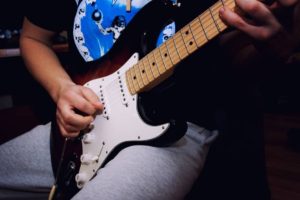
I find it quite amusing that most articles I read on beginner guitar don’t talk about this.
Yes, there are basic fundamentals to the guitar that every guitarist needs to have an understanding of.
In my opinion, if you know what type of guitarist you really want to be this will help you focus in on just that, that much faster.
For example, if you have no intentions of ever becoming a studio guitarist that can play any style and read sheet music in their sleep, why would you ever take the time and energy to learn how to read sheet music.
I know a lot of teachers that will disagree with me here, but if you’re inspired to play classic rock songs and jam with buddies, learning sheet music is quite literally a waste of time.
So I do believe that knowing from the get-go what type of guitarist you would like to be will help you lose some of the overwhelm on what to be focusing on and what you need to know vs. what you don’t. ( Guitar secret, many world famous guitarists, don’t read a lick of sheet music)
Tip 7: Learn with YouTube

I’m sure most of the readers here are already aware of the massive benefits of using YouTube on your guitar journey.
Just think that only a few years back if you wanted to learn how to play a G chord, you’d have to either learn to read a chord chart, purchase a chord book, or take private guitar lessons.
Nowadays, you can literally type anything into YouTube and have hundreds of guitarists teaching you what they know! How freaking cool is that! What a great time to be alive!
So here are just a few Pro’s and Also a few Con’s if you decide to go the YouTube route for learning.
Pros
You can literally search just about anything guitar related and learn something.
It’s free! ( Yeah they are getting worse with the annoying ads, but a small price to pay for endless hours of free lessons to improve your skill)
Cons
It’s free, a lot of people who “think,” they are good guitarists giving lessons, yet they have terrible form and teach bad habits.
If you are brand new how do you know what would be lousy technique vs. proper technique?
It can get overwhelming, if you’re just starting out with guitar, you don’t necessarily know where you need to start.
Hence why you might be reading this article right. So, if you choose to go this route make sure you have a plan as to what you’re going to learn, what you need to learn first, and which teachers on there are reputable and which ones aren’t.
Still, even with there being some big Cons, YouTube is a fantastic resource for guitarists.
Learning guitar visually with video allows you never to have to leave your home, to improve your skill tremendously and for that, it cannot be overlooked.
This is a great resource for beginner guitarists that want to learn free with YouTube.
Tip 8: Learn with an Instructor
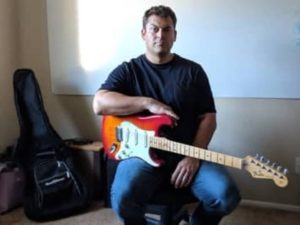
This is how I began and still recommend highly.
I know more and more people are using online methods only. This is okay if you have the basics down, but in my opinion, nothing beats taking a few lessons in person from a guitarist who has been doing this for years.
This can usually help cut your learning curve on basics quite quickly and for that fact has to be on the list.
Here are a few pros and cons to getting a guitar instructor.
Pros:
You get one on one instruction, your instructor will evaluate what you know and what you don’t.
They can help you determine where you need to get started and what you should be working on to get your basic foundational playing up to speed.
You have someone to ask your question to and get a response right then and there when your thinking of it.
Yes you could ask on forums, but you’ll get everyone’s opinions even grandma’s, and grandma may be using some old school technique, lol.
You have someone to keep you accountable, this is HUGE when just starting out.
Cons
It costs more than YouTube or an online platform. It will depend on your area for how much lessons cost but I wouldn’t expect to pay anything less than at least 25 bucks an experience, and that’s on the cheaper side.
You have to go to the lesson. Often people can’t commit to saying Thursdays at 4pm, every single week. This can cause some issues and be charged cancellation fees.
You only get one guitarist’s teaching and explanation style. Something that seems extremely difficult might be due to the way the instructor is teaching it.
With YouTube or a paid online platform, you can just find a different instructor if one isn’t floating your boat.
Tip 9: Learn with Online Paid Programs
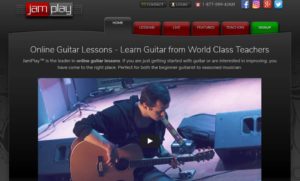
There are a lot of online paid programs now for guitar.
Usually, how this works is you become a member for a small fee each month, and you can log in at any time 24/7, and take lessons and work your craft.
Pros
Usually pretty cheap around 19 bucks a month.
Multiple highly qualified instructors teaching
Courses to keep you on track, so you’re never wondering what to work on next
Genre-specific lessons, want to learn country guitar, speed metal, or Texas blues? No problem, they teach it all, and you choose what you want to know.
Cons
I really can’t think of too many.
Possibly the only downside I can think of is if you are playing something wrong and you don’t know it, due to the fact that you don’t have some one teaching you in person to correct you.
Full Guitar Tricks Review Here.
Tip 10: Set up a practice schedule
This could probably be one of the most essential tips in this post.
Create a practice schedule is crucial to your development on guitar.
I know people today are busier than ever before. We all have the same amount of time in a day. If you want to learn guitar it’s going to take some consistency on your part.
What I recommend is coming up with an allotted time to dedicate to guitar each day. If it’s only 10 minutes, then so be it.
Make sure you do 10 minutes every single day.
Consistency is key here.
When you are learning something that has a ton of muscle memory attached to the learning process repetition is king.
So I know you might be thinking that you will devote 3 hours on Saturdays, I would highly encourage you to find short practice sessions that you can stick to throughout the week.
Still play on Saturday’s too, because the more you practice, the better you will become in a faster time frame.
Now as for what to be practicing that ultimately depends on where you are at skill wise right now. If you are an absolute beginner, you need to focus on getting your fingers to work individually and forming open chords.
Those two things could easily consume you for months, but that’s okay! Most songs aren’t more than 4-6 chords so once you learn the open chords, you can learn to play a TON of songs!
And that’s the reward for your hard work. I promise that once you are playing a song yourself that you recognize it will all be worth it and will only get better from there!
So don’t miss this step, creating a practice schedule will keep you on track and will allow you to hold yourself accountable if you don’t have an instructor.
Have fun coming up with this, as this is the habit that needs to form to truly learn the guitar and not be a 2 chord hack:)
Tip 11: Use a metronome from the beginning
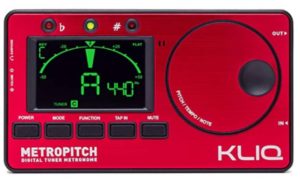
EVERYTHING you practice should be done so with a metronome.
The earlier you can get in the habit of playing to a metronome and working on keeping time the better of a guitarist you will be.
There are many guitarists out there that can solo like a maniac but can’t hold down a pure blues progression due to their lack of timing.
Timing is everything in music, and also if you ever decide to play with others, this will be crucial.
The best way to get into this habit is to purchase a metronome or download one with your smartphone.
I enjoy using this 2 in 1 tuner/metronome here. But get in the practice of using it anytime you are working on a strumming pattern, or even learning scales.
Tapping your foot in sync with the metronome will help internalize good time. Proper time is everything in guitar, so this tip is gold. Use it!
Tip 12: Track your progress

Tracking your daily practice is essential.
You can just use a simple notepad, or a document on your computer if you prefer, but monitor it.
There are a few reasons for doing this and most don’t. The first reason for doing this is it keeps you on track, you can quickly look at your previous practice session and see where you left off, and what needs your focus for today’s practice session.
Secondly, at the beginning of learning guitar, it can feel as if you aren’t improving and that your skill level isn’t going anywhere.
This will assure you a paper trail so that you can look back and realize that you ARE learning, it just takes time, patience, and consistency.
This is another tip that is pure gold that most people don’t actually do.
Make a habit of keeping a practice log, it will accelerate your skill level.
In Conclusion:
The guitar is such a fun adventure, but it may not feel fun in the beginning.
In fact, it may feel frustrating, impossible, and downright annoying. This is normal. This is where the people who don’t honestly have what it takes to learn the instrument give up.
Often when you are feeling this way, it actually means you are on the right track! I know it sounds counter-intuitive, but it isn’t.
Everything new is complicated in the beginning but if you continue to stay focused, stay consistent with your practice routine, and have patience.
Over time your skill level will improve, and the muscle memory will take over, soon you’ll be switching chords without thinking, and without skipping a beat.
This is where the guitar truly begins. Work hard, and most importantly have fun!


